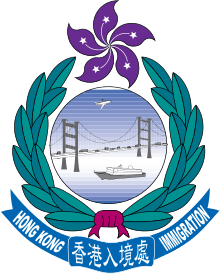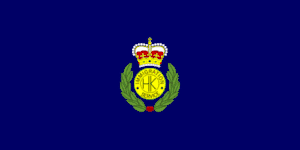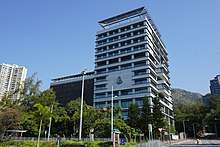Immigration Department (Hong Kong)
The Immigration Department of the Government of Hong Kong is responsible for immigration control of Hong Kong. After the People's Republic of China assumed sovereignty of the territory in July 1997, Hong Kong's immigration system remained largely unchanged from its British predecessor model. Residents from mainland China do not have the right of abode in Hong Kong, nor can they enter the territory freely, both before and after 1997. There are different regulations that apply to residents of Macau, another Special Administrative Region of China. In addition, visa-free entry acceptance regulations into Hong Kong for passport holders of some 170 countries remain unchanged before and after 1997.
| 入境事務處 | |
 | |
| Agency overview | |
|---|---|
| Formed | 4 August 1961[1] |
| Jurisdiction | Hong Kong |
| Headquarters | Immigration Tower, 7 Gloucester Road, Wan Chai |
| Employees | 6,569 |
| Minister responsible |
|
| Agency executive |
|
| Website | Official website |
| Immigration Department | |||||||||
|---|---|---|---|---|---|---|---|---|---|
| Traditional Chinese | 入境事務處 | ||||||||
| |||||||||
| Pre-handover Name | |||||||||
| Traditional Chinese | 人民入境事務處 | ||||||||
| |||||||||
 |
|
Politics and government of Hong Kong |
|
|
|
Legislature |
|
Court of Final Appeal
Special courts and tribunals: |
|
|
Related topics |
In a special arrangement, although Hong Kong's residents of Chinese descent are defined as citizens of the People's Republic of China, as stipulated by the Basic Law, Hong Kong's Immigration Department is responsible for issuing Hong Kong SAR passports for Hong Kong residents who are also PRC citizens seeking international travel.
History


Prior to the 1950s, immigration to Hong Kong was not controlled by the government of Hong Kong and migrants freely entered Hong Kong. By the end of World War II, the influx of migrants from China to Hong Kong to flee Communist rule resulted in immigration control.
From 1949 to 1961, registration of persons with identification was required under the Registration of Persons Ordinance 1949 and established a Commissioner of Registration.
Until the establishment of Immigration Department on 4 August 1961, immigration control in Hong Kong was handled by the Hong Kong Police Force.[2] The Immigration Service Ordinance 1961 created the new department in charge of immigration control. Later in 1977, the department enlarged its functions to cover registration of persons by amalgamating with the Registration of Persons Office and Director of Immigration also assumed as Commissioner of Registration.[3] In 1979, the department took over from the Registrar General civil registration duties and the Director of Immigration was appointed as Registrar of Births and Deaths, and Registrar of Marriages.
The Department is headquartered in the Immigration Tower in Wan Chai North.
Roles

The Department performs the following roles:
- Preventing visits by prominent human rights and democracy advocates, upon the direction of the mainland government.[4]
- Immigration control at the checkpoints (Hong Kong International Airport as well as Mainland-Hong Kong port of entry)
- HK Resident Affairs (by Division of Registration of Persons)
- Issuing Hong Kong Identity Card (both permanent and non-permanent)
- Birth registration
- Death certification
- Marriage certification
- Registering/Denouncing Chinese citizenship
- Naturalization of HK permanent residents who wish to be Chinese citizens
- Issuing Hong Kong Special Administrative Region passport to permanent residents who are Chinese citizens
- Issuing Hong Kong Document of Identity for Visa Purposes for HK residents who can obtain neither a national passport nor Hong Kong passport.[5]
Directors of the Immigration Department (Since 1 July 1997)
- Erick Tsang Kwok-wai (2016–present)
- Eric Chan, (2011-2016)
- Simon Peh, (2008–2011)
- Lai Tung-kwok, (2002–2008)
- Ambrose Lee, (1998 to 2002)
- Regina Ip (July 1997 to 1998)
Application for British National (Overseas) Passport
Prior to the handover of Hong Kong in 1997, the Immigration Department was responsible for processing BN(O) passport applications. After the handover, the UK Government then took over the issue of BN(O) passport.[6]
Ranks
As with all of the HK Disciplined Services, British-pattern ranks and insignia continue to be utilised, the only change being the exchange of the St. Edward's Crown for the Bauhinia Flower crest post-1997. The ranks are listed below with their UK equivalences in brackets:
- Director of Immigration (General)
- Deputy Director of Immigration (Lieutenant-General)
- Assistant Director of Immigration (Major-General)
- Senior Principal Immigration Officer (Colonel)
- Principal Immigration Officer (Lieutenant-Colonel)
- Assistant Principal Immigration Officer (Major)
- Chief Immigration Officer (Captain)
- Senior Immigration Officer (Lieutenant with a silver bar beneath)
- Immigration Officer (Lieutenant)
- Immigration Officer (Probationary) (Second Lieutenant) (with effect from 19 April 2010)
- Assistant Immigration Officer (Second Lieutenant) (discontinued in November 1998)
- Chief Immigration Assistant (three silver bars)
- Senior Immigration Assistant (two silver bars)
- Immigration Assistant (silver bar)[7]
List of notable activists refused entry to Hong Kong
| Name | Time |
|---|---|
| Chen Wei-ting | June 2014[8] |
| Benedict Rogers | October 2017[9] |
| Chang Tieh-chih | December 2017[10][11][12] |
| Victor Mallet | November 2018[13] |
| Freddy Lim | December 2018[14] |
| Albert del Rosario | June 2019[15] |
| Feng Congde | June 2019[16] |
| Dan Garrett | September 2019[17][18] |
| Kenneth Roth | January 2020[19] |
References
- Press Release
- "Registration of Persons Department". Archived from the original on 3 July 2009. Retrieved 25 March 2009.
- "Why China's move to bar Human Rights Watch chief from Hong Kong was contrary to the city's Basic Law". Hong Kong Free Press. 14 January 2020. Retrieved 15 January 2020.
- "Hong Kong Travel Documents". Retrieved 11 November 2012.
- "British national (overseas)". GOV.UK. Retrieved 14 March 2020.
- "Archived copy". Archived from the original on 16 February 2011. Retrieved 9 March 2011.CS1 maint: archived copy as title (link)
- "Hong Kong Denies Entry to Taiwan Author Who Supported Pro-Democracy Movement". Radio Free Asia. Retrieved 9 October 2019.
- Lee, Danny (11 October 2017). "British human rights activist refused entry to Hong Kong". South China Morning Post. Retrieved 3 September 2019.
- Ng, Kang-chung; Leung, Christy (7 December 2017). "Taiwanese politics and culture commentator Chang Tieh-chih barred from entering Hong Kong". SCMP. Retrieved 9 October 2019.
- Tong, Elson; Cheng, Kris (6 December 2017). "Taiwanese writer Chang Tieh-chih says he was denied entry to Hong Kong". Hong Kong Free Press. Retrieved 9 October 2019.
- Miao, Zong-han; Chang, S.C. "Taiwan protests after culture official denied entry to Hong Kong". Focus Taiwan. Retrieved 9 October 2019.
- Lum, Alvin; Su, Xinqi; Sum, Lok-kei; Ng, Naomi. "British Journalist Victor Mallet denied entry to Hong Kong as tourist". SCMP. Retrieved 22 September 2019.
- Chan, Holmes (24 December 2018). "Hong Kong says pro-independence Taiwan band member barred as he lacks 'special skills, knowledge or experience'". Hong Kong Free Press. Retrieved 25 September 2019.
- "Ex-Filipino minister denied entry to HK: lawyer". RTHK. Retrieved 26 September 2019.
- "Ex-Tiananmen leader denied entry into Hong Kong ahead of June 4". Hong Kong Economic Journal. Retrieved 4 September 2019.
- "Academic denied entry to HK after US testimony". RTHK. Retrieved 8 October 2019.
- "US academic denied Hong Kong entry after US Congress testimony". ABS-CBN News. Agence France-Presse. Retrieved 8 October 2019.
- 人權觀察執行長表示由紐約飛抵香港後被拒入境 . RTHK. 2020-1-13
Order of precedence
| Preceded by Hong Kong Police Force |
Immigration Department (Hong Kong) since 1961 | Succeeded by |
External links
| Wikimedia Commons has media related to Immigration Department (Hong Kong). |
